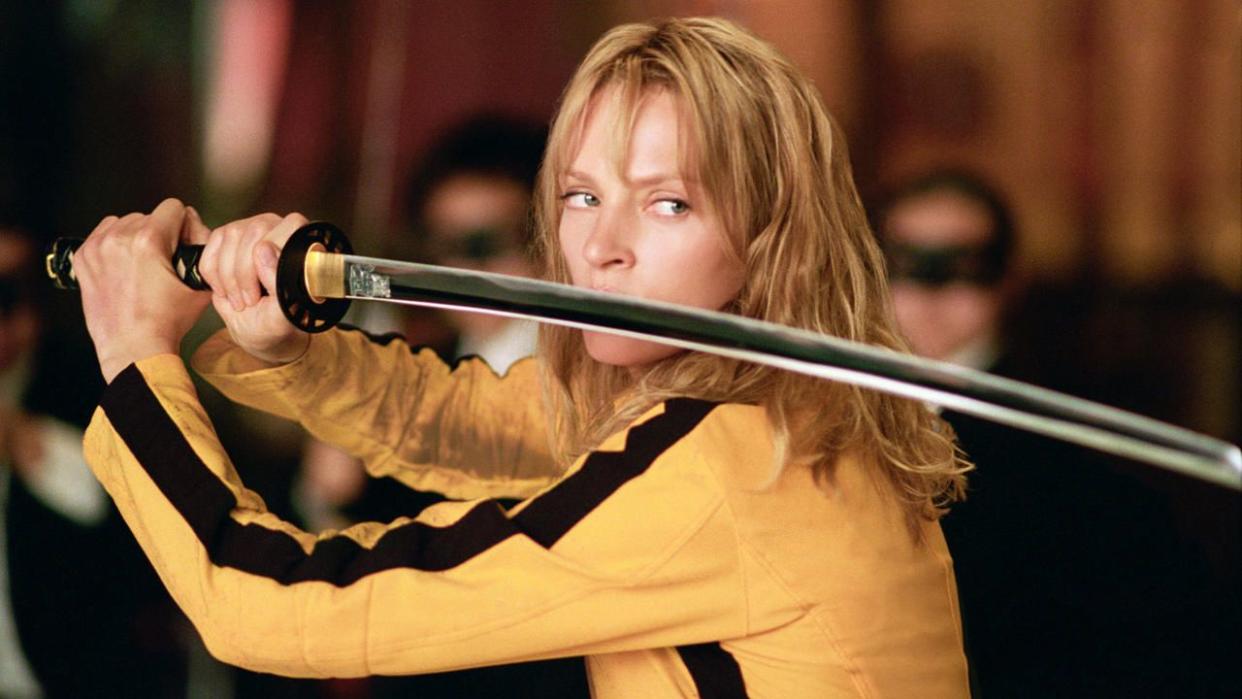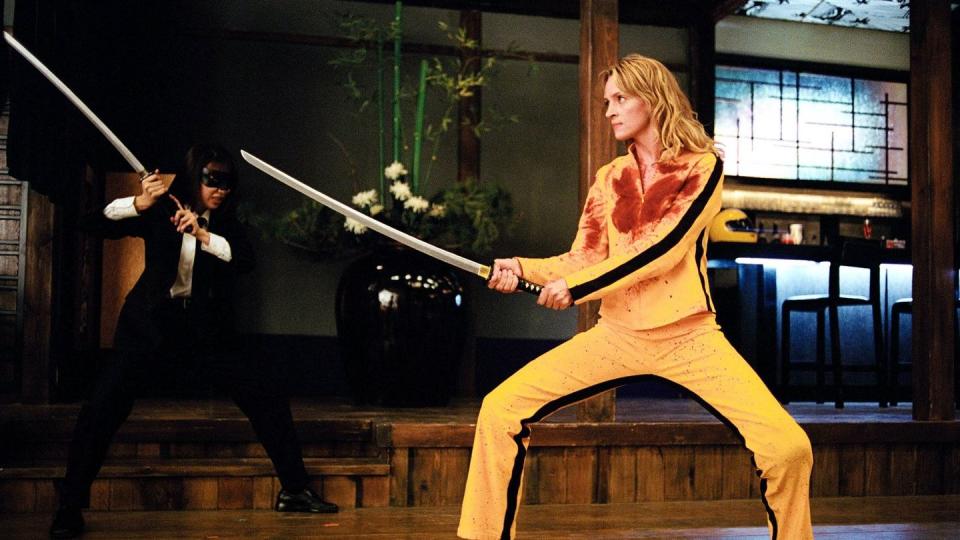'Kill Bill Volume 1' Is the Most Quentin Tarantino Film of Them All

Barbie landed at the multiplex this summer like a pink confetti bomb, flashing a sweet smile, boogying to a Dua Lipa song, and blithely crushing the patriarchy under one (permanently) arched foot. Two decades before Greta Gerwig’s Barbie, though, Quentin Tarantino lured legions of moviegoers with his own bloodied, baroque take on essentially the same formula. In 2003's Kill Bill Volume 1, Tarantino similarly gifted us a canonical blonde, a feminist even film bros could appreciate, and a deathless Halloween costume.
Kill Bill Volume 1, released 20 years ago this week, isn’t strictly the best Tarantino film, but it is maybe the most Tarantino. The film is the purest expression of his id, or at least his abiding interests: kung fu, classic grindhouse, lingering closeups of ladies’ feet. Volume 1 is like a Wu-Tang album in its clarity of purpose and fondness for martial-arts mythology. (In fact, RZA curated the movie's choogling soundtrack of rockabilly, vintage funk, and spaghetti-western brass.)
Volume 1 is also a sensational showcase for Uma Thurman, who plays a character as ruthlessly focused—and frankly, lethal—as any squinty-eyed avatar of 20th-century screen machismo the film so freely pulls from. Thurman is The Bride, an assassin who emerges from a four-year coma after barely surviving a wedding-day massacre at an El Paso chapel (baby in her belly and all) at the hands of her former bossman-slash-lover Bill (spoiler: it’s David Carradine, unseen till Vol. 2) and his Deadly Vipers crew.
Furious and primed for vengeance, The Bride makes quick work of a rapey orderly (Breaking Bad's Michael Bowen, we hardly knew ye), takes the keys to his Chevrolet, and sets off to eliminate everyone who put her in that hospital bed. (Pour one out for the Pussy Wagon, which has since had its wings clipped, but still looks like a flaming chariot Guy Fieri would ride straight to Flavortown).
The first target on her list is Viper-turned-suburban housewife Vernita Green (Vivica A. Fox), who goes down relatively easy, undone by a poorly-aimed cereal-box pistol and a knife to chest. Tokyo yakuza queen O-Ren Ishii (Lucy Liu) takes more long-range planning—and a sharper blade. Retired swordsmith Hattori Honzo (late black-belt legend Sonny Chiba) supplies the hard-earned hardware: a katana that slices through limbs and sinew like hot butter. O-Ren’s gang of deadly minions, the Crazy 88, serve as the first line of defense.
The battle that ensues, the Showdown at the House of Blue Leaves, provides the movie’s spattered, balletic centerpiece. It's a whirling triumph of wet-work choreography that took a reported two months to film. (Though you will have to take on faith that the rivers of blood are not motor oil or chocolate syrup; for nearly half the scene, Tarantino flips his camera to black and white). Even the sociopathic schoolgirl bodyguard Gogo Yubari (Chiaki Kuriyama), with her swinging meteor hammer, cannot beat the combined force of the Bride’s true grit and a convenient chunk of nail-spiked plywood.
O-Ren eventually meets her end once the 88s are 86’d, the top of her skull sliced off like a fresh baguette. Only her loyal consigliere Sofie Fatale (Julie Dreyfus), now stripped of both her Chesire grin and her right arm, is allowed to live to tell the tale, but with the grip of Bill’s hand on her shoulder. Bill's face and body is out of frame, but still, he asks: Does the Bride know that the child she thought died inside her four years ago is still alive?
Fin. Cut to black.
Of course, that is not actually the end: In order to let Kill Bill's full, unexpurgated glory unfold as Tarantino originally conceived it, Miramax allowed him to split the movie into two parts, with Volume 2 to follow six months later. (The decision paid off. Volume 2 earned an additional $152 million on top of Volume 1's $180 million box office total.) Far broader and more expansive—the runtime is nearly half an hour longer than its predecessor—the second volume features more elaborate deaths and unspools reams of expository dialogue. Adorable-moppet offspring is revealed. Final vengeance, duly served. (Do your thing, Five Point Palm Exploding Heart Technique.)

The “sequel” makes the whole thing richer, and fills in all kinds of narrative gaps—for one, the entire El Paso wedding day. But there’s something about the standalone qualities of the first film, and its steadfast refusal to provide more than the bare bones of plot and motivation before setting the Bride on her course. (Even her real name, Beatrix Kiddo, isn’t revealed without its obscuring bleeps until halfway through Vol. 2.)
I don’t want to belabor the Barbie metaphor too much. One is a living doll Velveteen-Rabbiting her way to higher consciousness via bubblegum gingham and the Indigo Girls; the other is a trained killer who casually splits a man in two and plucks out eyeballs like she’s sampling grapes at Trader Joe’s. But both films do the fairly radical thing of simply allowing their female protagonists to exist on screen as complicated, emotionally intelligent, internally motivated beings—without lazy objectification or apology. Thurman’s Bride, in her gore-spattered jeans and T-shirts and immortal yellow tracksuit, doesn’t dress (or undress) for the male gaze, and she doesn’t fight at the behest of anything but her own code of honor. (It probably doesn’t hurt that Thurman co-conceived the story. She's the “U” in the “Q&U” both Kill Bills are credited to.)
There are a thousand hours of film scholarship exploring Tarantino’s vast catalog of deep-cut references and soundtrack cues, his signature bag of auteur tricks and embellishments (the black and white, the blood geysers, the crash zooms). But then there is the primal pleasure of just watching it unfold on screen: 21st-century cinema’s most indelible, unkillable Bride, righteously slashing and burning her way to justice till death (R.I.P., Vol. 3) do us part.
You Might Also Like


